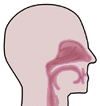  |
||
 |
June 2017Can there be direct stimulation of olfactory epithelial stem cells to generate olfactory receptor cells?Presently we use various mechanisms to activate olfactory receptor stem cells to react to increased secretion of growth or transcription factors to stimulate these olfactory stem cells to generate olfactory receptors and improve smell function. At present this involves application of phosphodiesterase inhibitors, small molecules which act by inhibiting metabolism of these growth factors to their metabolic inactive forms thereby increasing concentrations of these active growth factors. By this technique, we have stimulated these stem cells by increasing secretion of these growth factors INDIRECTLY resulting in increased olfactory receptor number and improved smell function. We have measured increased growth factors cAMP, cGMP and sonic hedgehog by use of these techniques (1). Can there be a method to stimulate olfactory receptor stem cells DIRECTLY to induce generation of olfactory receptor cells? Study of in vitro culture of mouse hair cells suggest that DIRECT stimulation of supporting cells and hair cells from the inner ear by several small molecular moieties has induced stem cells of the cochlea to generate growth and development of hair cells, the cells involved with hearing (2). These techniques involve the overexpression of Lgr5+ cells in the inner ear, moieties which then convert these progenitor cells into hair cells which suggests a therapy to improve hearing (2). Could a similar technique act to stimulate DIRECTLY stem cells in the olfactory epithelium to induce development of olfactory epithelium cell receptors so that we can use this technique as a mechanism to directly improve smell loss?
|
|